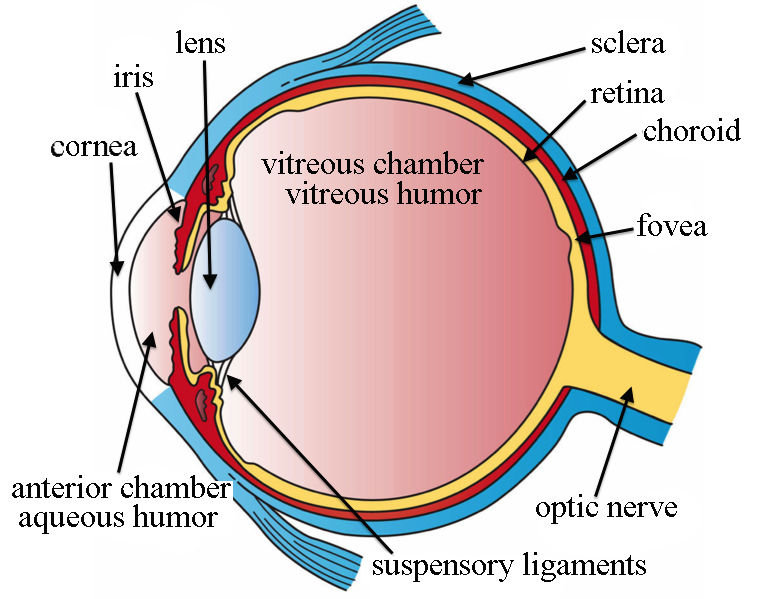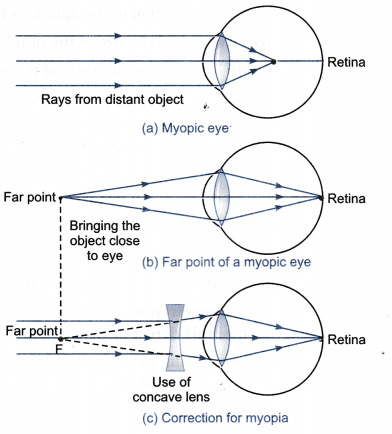The Human Eye and the Colorful World
10.1 The Human Eye
A Biological Camera: The human eye is often compared to a camera, and for good reason! It has a complex lens system that captures light and focuses it to form an image.
Journey of Light: Light enters the eye through the cornea, a transparent outer layer. It then passes through the pupil, a hole whose size is controlled by the iris (the colored part of your eye). The light then goes through the lens, which focuses it onto the retina.
The Retina: The retina is like the "film" of the eye. It's a layer at the back of the eye that contains special cells called photoreceptors. These cells are sensitive to light and convert it into electrical signals.
To the Brain! The electrical signals from the photoreceptors travel through the optic nerve to the brain, where they are interpreted as images.

10.1.1 Power of Accommodation
Focusing Power: One of the amazing things about the human eye is its ability to focus on objects at different distances. This is called accommodation.
Muscles and Lens: Tiny muscles called ciliary muscles control the shape of the lens. When you look at something far away, the muscles relax, and the lens becomes thinner. When you look at something close, the muscles contract, and the lens becomes thicker.
Near Point and Far Point: The near point is the closest distance at which you can see an object clearly. For young adults, it's typically around 25 cm. The far point is the farthest distance at which you can see clearly. For a normal eye, the far point is infinity.
Cataract: Sometimes, the lens can become cloudy, like a frosted window. This is called a cataract and can cause blurry vision or even blindness. Thankfully, cataracts can often be treated with surgery.
10.2 Defects of Vision and Their Correction
Refractive Errors: When the eye's lens system doesn't focus light perfectly on the retina, it results in refractive errors. These are common vision problems that can usually be corrected with glasses or contact lenses.
Myopia (Near-sightedness): People with myopia can see nearby objects clearly but have trouble seeing distant objects. This happens because the eyeball is slightly too long or the lens is too curved, causing the image to focus in front of the retina. Concave lenses are used to correct myopia.

Hypermetropia (Far-sightedness): Hypermetropia is the opposite of myopia. People with this condition can see distant objects clearly but have difficulty focusing on near objects. This occurs because the eyeball is too short or the lens is not curved enough, causing the image to focus behind the retina. Convex lenses are used to correct hypermetropia.

Presbyopia: This is an age-related condition where the lens gradually loses its flexibility, making it harder to focus on near objects. It's a natural part of aging and is often corrected with bifocal lenses, which have different parts for near and far vision.
10.3 Refraction of Light Through a Prism
Bending Light: A prism is a triangular piece of glass or plastic that bends light. This bending is called refraction and occurs because light travels at different speeds in different mediums.
Angles and Deviation: When light enters a prism, it bends towards the normal (an imaginary line perpendicular to the surface). When it exits the prism, it bends away from the normal. The angle between the incident ray (incoming light) and the emergent ray (outgoing light) is called the angle of deviation.

10.4 Dispersion of White Light by a Glass Prism
Rainbow Colors: White light, like sunlight, is actually a mixture of different colors. When white light passes through a prism, it undergoes dispersion. This means the different colors of light are separated because they bend at slightly different angles.
VIBGYOR: The colors of the spectrum are often remembered by the acronym VIBGYOR: Violet, Indigo, Blue, Green, Yellow, Orange, and Red. Red light bends the least, while violet light bends the most.

10.5 Atmospheric Refraction
Earth's Atmosphere as a Lens: The Earth's atmosphere can act like a giant lens, bending light from celestial objects. This leads to some interesting effects.
Twinkling Stars: Stars appear to twinkle because their light passes through different layers of the atmosphere with varying densities. This causes the light to bend in different directions, making the star's apparent position and brightness fluctuate.
Why Planets Don't Twinkle: Planets are much closer to Earth than stars, so they appear as tiny disks rather than points of light. The variations in their light due to atmospheric refraction average out, so they don't twinkle as much.
Early Sunrise and Late Sunset: Atmospheric refraction also causes the Sun to appear about 2 minutes earlier at sunrise and 2 minutes later at sunset than it actually is. This is because sunlight is bent as it passes through the atmosphere.
10.6 Scattering of Light
Tyndall Effect: Have you ever noticed how a beam of sunlight becomes visible when it shines through dusty air? This is the Tyndall effect. It's caused by the scattering of light by small particles in the air.
Why is the Sky Blue? The sky appears blue because of a phenomenon called Rayleigh scattering. Air molecules are much smaller than the wavelengths of visible light. Blue light, which has a shorter wavelength, is scattered more strongly by these molecules than other colors, especially red light, which has a longer wavelength. This scattered blue light reaches our eyes, making the sky appear blue.